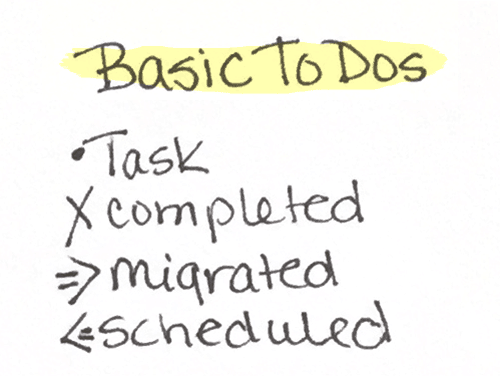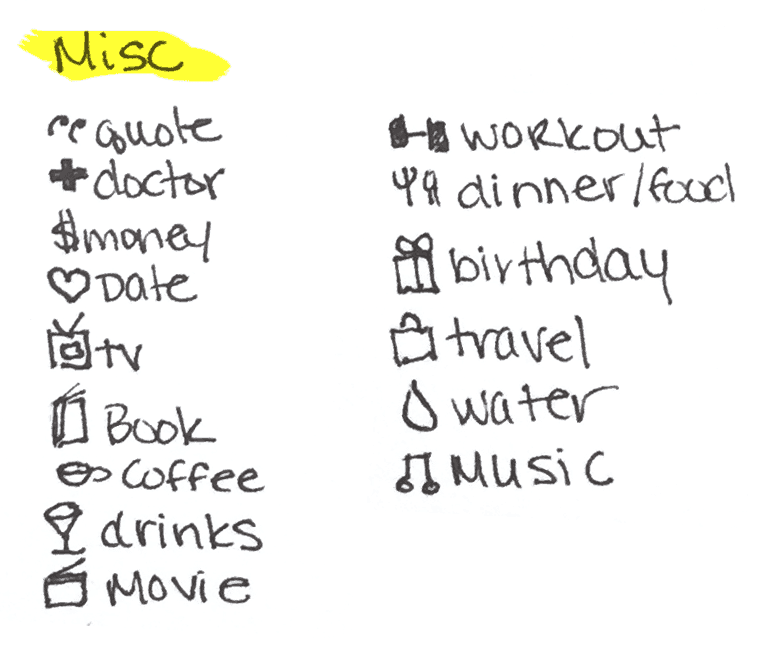All my best tips and ideas for how to get started with a bullet journal, including how to make the symbols, possible bullet journals to use (including a super creative suggestion!) and how to do your logs!
This post contains affiliate links. If you purchase anything, I earn a small commission at no extra charge to you. Thanks for your support!
These days we are constantly bombarded with distractions. Phones ringing and pinging, emails popping up, TV and movies on demand, on the go. It makes it hard to disconnect and focus. In fact, while some attribute lack of focus on ADHD, for many it's really ADT or attention deficit trait, which is a learned behavior.
The difference being those with ADD can't focus but those with ADT are capable of focus and attention, but find it easier to give in to the temptation of that ringing and dinging. Multi-tasking isn't actually productive since our brains aren't able to split attention. So in order to regain focus, some are using a system called bullet journaling.
Science of physically handwriting
Bullet journaling combines the known science of physically handwriting down things, which makes them twice as easy to recall, and the ability to mentally let go of the things competing for our attention.
Once written down you can focus on one, knowing the others aren't forgotten, but written down for future reference. Writing things down to quiet the mind is a long used strategy for many, and bullet journaling is a system that takes jotting down notes to a level of self-discovery.
Rapid logging
If you want to try bullet journaling, here is a synopsis of the steps and strategies. First is rapid logging. Rapid logging is sort of like note taking or journaling, just simpler. This is especially important for those who have tried traditional journaling but lost interest because of the time and effort it takes.
Rapid logging consists of four components: topics, page numbers, short sentences, and bullets.
Topics
Topics are added to the outer corner of the page. It is just a short descriptive title. If you need to take a bit to think it through, do so since that topic can help you with clearer entries.
Page numbering is rather self explanatory, but a very important part of the process. Be sure you put a topic and number pages before you start with your content.
Bullet Journal Bullets
The next part of rapid logging is bullets and they include short sentences. Bullets are lists of short sentences preceded with a symbol. For rapid logging your bullets are organized into three categories: tasks, events and notes.
Related post: HUGE List of Bullet Journal Symbols
Task
The symbol for tasks should be a simple dot “•” and are just what they sound like, items that you need to do: errands and so forth.
The task bullet is a large part of your Bullet Journal so it has three additional notational organization: X = Task Complete; > = Task Migrated; < = Task Scheduled.
Events
The symbol for events should be an open circle. Events are date related, obviously, and are used for future and past items.
For instance if your friend's birthday is coming up that is a scheduled event or if you log something that happened that day it's a past item.
Keep these entries brief and objective. Remember this is just a place to note it quickly. You can write more about it later. The symbol for notes should be a dash “-“.
Notes
Notes are facts, ideas, thoughts or observations. They are things that you want or need to remember, but can't or don't want to take the time to take action on them now.
Additional symbols… You can also come up with additional symbols, or signifiers, to use for other things.
One is set priority. You can come up with your own, but an asterisk “*” next to a bullet can make it easier to spot important items in a list. For great ideas or inspirations, use an exclamation point. I use a triangle in mine to see things I have to do AND that are important! The cool thing about bullet journalling is you can make it your own!
Items to explore at more length, research or expound upon later can have an eye. Again, you can come up with your own, but these work well too.
Modules
Your bullet journal sets up a framework for the next step: modules. Modules are designed to help you organize and easily find certain kinds of entries.
The four core modules: The Index, Future Log, Monthly Log, Daily Log.
The beauty of this system is you can mix and match as you need.
Index
The index is the first few pages of your bullet journal. Kind of like a table of contents, but evolving as you use it.
When you first start a journal you won't really know what to put there, so save a few pages for this purpose. As you get going, you will find that you have notes and tasks that have a common theme. Creating a collection to more easily find them is a smart idea.
Your index will eventually have collections listed with the topics and page numbers. Write topics as “Name: page numbers” leaving space to add additional page numbers as you get to them.
Future Log
The future log is a collection of items that need to be done far in the future or for things that you eventually want to get to.
For instance if you schedule a vacation for May in the previous October, jot it down. Set this section up by using a graph of the amount of months you’ll need, i.e. two horizontal lines across facing pages creates a six-month calendar, for example.
Monthly Log
The monthly log organizes your month. It is a calendar and task list. Use two new facing pages and set up it so the calendar page is on the left and task page is on the right.
Set the calendar page up like this: Title the page with the name of the month, then list all of the days down the left margin followed by the first letter of the corresponding day. It would look like this, Tuesday the 10th would be “10T”.
Use the Calendar Page to schedule Events and Tasks, and record Events after they happen keeping the entries short and to the point. This page is for reference only.
The Task Page is a list of both Tasks you want to do that month, and carry-overs from the previous month.
Daily Log
The daily log organizes your day. At the top of the page write the date as the topic. Then use it to rapid log tasks, events and notes. Don't set up your daily logs ahead of time. Create them as you go since you don't know how much space you'll need.
Migrating
The next important part of bullet journaling is migrating. Migrating is the movement of tasks and events from day to day and month to month. It will help you find unresolved tasks or notes that you haven't addressed.
Those items may have become irrelevant, so strike through those items on the page it was first noted. If you find tasks, events or notes that need to still need to be addressed, change the “•” into “>” and add it to the new monthly log.
When you’re setting up a new month, migrate any entries scheduled for that month from your future log into your new monthly log. Scheduled items are migrated to the monthly log’s calendar page.
The purpose of writing things over and over is to make you consider each as you rewrite it. If it's not worth rewriting, strike it out.
Migration helps you focus on the things that are truly worth the effort. This will help you become aware of patterns and habits, and to strike out the distractions.
I have to say that the rewriting is the best part of bullet journaling for me. I find that I am much more aware of unnecessary tasks when I have to write them over and over than if they are just riding in my online calendar as a task I ignore over and over again!
So go find a blank book and get started!
Dylusions Dyalog Canvas Cover Dotted Bullet Notebook Journal
Dotted Bullet Notebook Journal The Bullet Journal Method
The Bullet Journal Method







 Tara’s “tell it like it is” personality combined with her 100 miles per hour presentations have earned her the title “The Queen of Marketing Ahhh’s” from her raving fans. Check out her marketing courses and products at her Etsy Store,
Tara’s “tell it like it is” personality combined with her 100 miles per hour presentations have earned her the title “The Queen of Marketing Ahhh’s” from her raving fans. Check out her marketing courses and products at her Etsy Store,